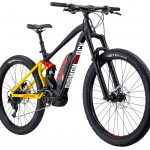Bosch ebike motor reliability
- Thread starter Tofu21
- Start date
Loads applied to all "rolling element" bearings both when static or dynamic can do damage, so-called "brinelling".The load on a static (not rotating) bearing will not have any effect on wear rate, full sus, rigid, standing or sitting the bearing needs to rotate before it will wear.
Example, stick a handful of sand in your underpants and stand still, no probs, now try running

https://en.wikipedia.org/wiki/Brinelling
I have no idea if this is the issue with these motors but it is very evident simply by inspecting the trackway normally seen first on the inner track. It is a very common mode of failure, for example, it is typically the cause of wheel bearing failures on bikes and cars alike.
Order your parts from AdrenalineATV, Very knowledgeable,helpful and efficient and they don't care where your bike came from.Will he sell parts to us mere mortals now ... or only to his own customers who purchased their bike from him?
His web site indicates he won't sell anything to anyone else.
Definitely found Adrenalin ATV to be the most helpfull of all e-bike stores that I have dealt with.Order your parts from AdrenalineATV, Very knowledgeable,helpful and efficient and they don't care where your bike came from.
I’m not sure if it’s a good thing but it reassures me that there is usually a Bosch motor in pieces on the shelves there when I visit.
I looked at their web site but couldn't see a list of parts accessories available.... am I just dopey.
Website... Menu.... Shop.I looked at their web site but couldn't see a list of parts accessories available.... am I just dopey.
That should do the trick
Although they respond quickly to emails and phone calls.
Its a Local Shop for Local People TubsI looked at their web site but couldn't see a list of parts accessories available.... am I just dopey.
I would also suggest that an asymmetric bearing design might make a lot of sense in this application. Multiple bearings on the high load side.
[QUOTE
I don't believe that any make of current crank drive electric motor (DU) as fitted to eMTB's is not going to be susceptible to outer bearing failure, especially if the bike is used in Europen off road conditions.
Excellent Reply Eddie with well-considered and interesting information.
Whether I am a fitter rider or not I tend to only use the lowest eco level of assistance for the majority of the time on my PU Yamaha engine bike and had wondered myself whether the power I add to the pedals is more likely to cause wear to the main bearing than a rider that uses more motor power and less pedal power.
As you say at some point with any DU motor which replaces the bottom bracket of a normal bike the bearing that deals with the forces delivered by the motor and pedals will eventually wear out.
In my case as a high milage commuter this happened at 6000 miles and just after the two-year warranty expired. As with any bearing that wears it had probably been getting worse for some time before my blunt mechanical sympathy was finally made to accept that something was wrong.
I was lucky that the Bike shop I bought from (Ebike shop Farnham) were good enough to replace the motor free of charge in double quick time. Well done to them.
I believe that Yamaha rather than repairing a motor take the view that replacing a motor is easier within the guarantee period. However, the motor still worked properly and it was the bearing that was worn out.
When I reach that point again with the new motor it will be interesting to see whether the shop will advise me that they can replace this bearing or again suggest a new motor.
Maybe manufacturers take a slightly cynical view that the majority of owners will not ride far enough for this bearing to fail within the warranty period.
In this time of unit construction and a throw away attitude to many products etc it may be seen as simply easier to take a motor with a worn bearing out and shove a new motor in.
You would think that a good motor design should have a quality well protected bearing with a good life expectancy and that the design allows for the bearing to be replaced relatively straight forwardly in due course.
Your point about cleaning products potentially effecting the life expectancy of bearings is interesting.
I have known for some time not to use a high-pressure hose as this can force water beyond seals into bearings and cause premature failure of either wheel, bottom bracket, motor or anywhere else
I have used products like muc off and you have made me wonder whether I should stick to just an ordinary hose and chain lube. What products do you recommend for basic washing down a dirty muddy bike?
My own experience of my original Yamaha battery has so far been good.My battery still continues to show little sign of degradation after 2 years and 7 months and 7470 miles.
However, a regular commute to work may be a kinder application for a battery than leisure use as I am never exploring the full extent of the range. I leave my battery indoors after returning from work with usually about a 65% charge and then only charge it back up to 100% just before I set off for work. Again, I have about 65% left when I get to work and can charge it back up before my trip home.
However using the link provided by lzzyekerslike to the Yamaha service manual allowed me to check the health of my battery and perhaps not surprisingly I found that I had charged my battery more than 700 times the maximum measurement available.
However the same service manual allowed me to check in a rather crude way the absolute battery capacity of my battery and it is still showing the highest battery capacity that can be indicated by this test ie 75% to a %100. As a commuter doing a similar milage each day I never find out how the maximum distance my bike can achieve now has been affected by its age and continual use. It does however broadly use the same amount of capacity on my journey too and from work as it always has.
Again perhaps a little cynically you could argue that the above tests allow a shop to refuse to replace a battery within its warranty period as the shop can demonstrate that the battery capacity has not fallen beneath 75% hense that parameter!
Bottom line is that I could not commute to work and back carrying two loaded panniers on an ordinary bike let alone cross country using a selection of xc routes that now include some quite demanding ones.
As I said in the conclusion of my review of my bike after the first 1600 miles of use, “ I am still very impressed with this bike. I think that the combination of the Haibike frame and Japanese motor are a great combination and hard to beat. I have ended up with a highly capable mountain bike and fast road bike that can also lug me and two full panniers around with consummate ease. More importantly than all this is that riding this bike is amazing fun and it has enabled me to commute to work by bicycle and leave the car at home which I could not have done on an ordinary bike. You obviously also get a lot of exercise in a way that you hardly notice.
If anything I am even more impressed now that I have covered over 7500 miles. The basic cost of my bike was £1750, and I am getting a lot of fun out of it.
Perhaps the shops that sell them need to raise their game and be able to much more quickly reliably sort out any problems you get. These bike cost a lot and should have the best quality after sales support. I am not sure that for the majority of people that is the case. Hopefully as more and more are sold competition for business will force shops to become better in this respect. I am grateful that the shop where I bought mine is local to me and has turned out to be exceptionally good at after sales support when I have required it.
I don't believe that any make of current crank drive electric motor (DU) as fitted to eMTB's is not going to be susceptible to outer bearing failure, especially if the bike is used in Europen off road conditions.
Excellent Reply Eddie with well-considered and interesting information.
Whether I am a fitter rider or not I tend to only use the lowest eco level of assistance for the majority of the time on my PU Yamaha engine bike and had wondered myself whether the power I add to the pedals is more likely to cause wear to the main bearing than a rider that uses more motor power and less pedal power.
As you say at some point with any DU motor which replaces the bottom bracket of a normal bike the bearing that deals with the forces delivered by the motor and pedals will eventually wear out.
In my case as a high milage commuter this happened at 6000 miles and just after the two-year warranty expired. As with any bearing that wears it had probably been getting worse for some time before my blunt mechanical sympathy was finally made to accept that something was wrong.
I was lucky that the Bike shop I bought from (Ebike shop Farnham) were good enough to replace the motor free of charge in double quick time. Well done to them.
I believe that Yamaha rather than repairing a motor take the view that replacing a motor is easier within the guarantee period. However, the motor still worked properly and it was the bearing that was worn out.
When I reach that point again with the new motor it will be interesting to see whether the shop will advise me that they can replace this bearing or again suggest a new motor.
Maybe manufacturers take a slightly cynical view that the majority of owners will not ride far enough for this bearing to fail within the warranty period.
In this time of unit construction and a throw away attitude to many products etc it may be seen as simply easier to take a motor with a worn bearing out and shove a new motor in.
You would think that a good motor design should have a quality well protected bearing with a good life expectancy and that the design allows for the bearing to be replaced relatively straight forwardly in due course.
Your point about cleaning products potentially effecting the life expectancy of bearings is interesting.
I have known for some time not to use a high-pressure hose as this can force water beyond seals into bearings and cause premature failure of either wheel, bottom bracket, motor or anywhere else
I have used products like muc off and you have made me wonder whether I should stick to just an ordinary hose and chain lube. What products do you recommend for basic washing down a dirty muddy bike?
My own experience of my original Yamaha battery has so far been good.My battery still continues to show little sign of degradation after 2 years and 7 months and 7470 miles.
However, a regular commute to work may be a kinder application for a battery than leisure use as I am never exploring the full extent of the range. I leave my battery indoors after returning from work with usually about a 65% charge and then only charge it back up to 100% just before I set off for work. Again, I have about 65% left when I get to work and can charge it back up before my trip home.
However using the link provided by lzzyekerslike to the Yamaha service manual allowed me to check the health of my battery and perhaps not surprisingly I found that I had charged my battery more than 700 times the maximum measurement available.
However the same service manual allowed me to check in a rather crude way the absolute battery capacity of my battery and it is still showing the highest battery capacity that can be indicated by this test ie 75% to a %100. As a commuter doing a similar milage each day I never find out how the maximum distance my bike can achieve now has been affected by its age and continual use. It does however broadly use the same amount of capacity on my journey too and from work as it always has.
Again perhaps a little cynically you could argue that the above tests allow a shop to refuse to replace a battery within its warranty period as the shop can demonstrate that the battery capacity has not fallen beneath 75% hense that parameter!
Bottom line is that I could not commute to work and back carrying two loaded panniers on an ordinary bike let alone cross country using a selection of xc routes that now include some quite demanding ones.
As I said in the conclusion of my review of my bike after the first 1600 miles of use, “ I am still very impressed with this bike. I think that the combination of the Haibike frame and Japanese motor are a great combination and hard to beat. I have ended up with a highly capable mountain bike and fast road bike that can also lug me and two full panniers around with consummate ease. More importantly than all this is that riding this bike is amazing fun and it has enabled me to commute to work by bicycle and leave the car at home which I could not have done on an ordinary bike. You obviously also get a lot of exercise in a way that you hardly notice.
If anything I am even more impressed now that I have covered over 7500 miles. The basic cost of my bike was £1750, and I am getting a lot of fun out of it.
Perhaps the shops that sell them need to raise their game and be able to much more quickly reliably sort out any problems you get. These bike cost a lot and should have the best quality after sales support. I am not sure that for the majority of people that is the case. Hopefully as more and more are sold competition for business will force shops to become better in this respect. I am grateful that the shop where I bought mine is local to me and has turned out to be exceptionally good at after sales support when I have required it.
Last edited:
[QUOTE
In this time of unit construction and a throw away attitude to many products etc it may be seen as simply easier to take a motor with a worn bearing out and shove a new motor in.
[/QUOTE]
A motor is just a component, just as a bearing assembly is a component and I think it really is just a question of what level of component it is most efficient to exchange. For warranty claims that seems at present to be the whole motor and I wouldn't be surprised to see a replacement/reconditioned motor offering coming for out of warranty repairs either.
That said, I also see coming the availability of 3rd party bearing sets on ebay for home mechanics as well.
In this time of unit construction and a throw away attitude to many products etc it may be seen as simply easier to take a motor with a worn bearing out and shove a new motor in.
[/QUOTE]
A motor is just a component, just as a bearing assembly is a component and I think it really is just a question of what level of component it is most efficient to exchange. For warranty claims that seems at present to be the whole motor and I wouldn't be surprised to see a replacement/reconditioned motor offering coming for out of warranty repairs either.
That said, I also see coming the availability of 3rd party bearing sets on ebay for home mechanics as well.
D
Deleted member 4366
Guest
Motorcycles have a drive sprocket that works in a more hostile environment than those ebike ones, and it bears considerably more load. Sure, they'll wear out eventually, but not normally within the life of the motorcycle. It's just a question of design and quality control.
The designers of these ebike motors are balancing weight, cost, function and durability. I think they skimped on the durability.
The designers of these ebike motors are balancing weight, cost, function and durability. I think they skimped on the durability.
Sorry , not posted in a while as concentrating on summer road biking and now it's cold and wet have decided to get the ebike back into use..
Just to let you know that I recent,y had to get my wife's KTM ebike repaired. Faulty motor -2015 Bosch Powerline fitted to a KTM TOUR 10 Plus with only 1,000 dry miles ..used by my wife who is 8. Stones wet through only during dry weather. Bike stored in heated garage.
That's two bikes we have had to get motors replaced...both are 2015 models
Is there an issue with 2015 Bosch drive units ?
Just to let you know that I recent,y had to get my wife's KTM ebike repaired. Faulty motor -2015 Bosch Powerline fitted to a KTM TOUR 10 Plus with only 1,000 dry miles ..used by my wife who is 8. Stones wet through only during dry weather. Bike stored in heated garage.
That's two bikes we have had to get motors replaced...both are 2015 models
Is there an issue with 2015 Bosch drive units ?
Anyone want to buy a 2015 KTM Lycan Macina GPS+?
In the end I had three people after mine, so hopefully if priced correctly, it won't hang around.
.
I have the 2018 Cube Reaction Hybrid race 500, bought from Evans 10 weeks ago. Very pleased with it I have to say.
BUT on a ride last week, I suddenly noticed feeling vibration in the pedals, a little more so the left. This is much more noticeable in the higher gears and
BUT on a ride last week, I suddenly noticed feeling vibration in the pedals, a little more so the left. This is much more noticeable in the higher gears and
Continued : goes away in the bottom 2 gears.
I just wondered what are the "Symptoms" of Bosch CX bearing failure, before I go back to Evans with an issue of the guarantee ?.
The bike is used in Eco and Tour 99% of the time and in all weathers, but on urban off road routes. Poorly maintained here in Gateshead .
Any thought welcome.
I just wondered what are the "Symptoms" of Bosch CX bearing failure, before I go back to Evans with an issue of the guarantee ?.
The bike is used in Eco and Tour 99% of the time and in all weathers, but on urban off road routes. Poorly maintained here in Gateshead .
Any thought welcome.
well you can try to see if there is any play in the bearing buy moving the crank arms left right up and down but i doubt it is that but could be.
do you remove the front sprocket and clean it? as i get the same thing if the lock ring starts coming loose so check that.
i also keep the hole drive chain as clean as possible and lube b4 every ride.
do you remove the front sprocket and clean it? as i get the same thing if the lock ring starts coming loose so check that.
i also keep the hole drive chain as clean as possible and lube b4 every ride.
Thanks soundwave. No play on cranks when I checked. I have not cleaned sprocket yet.
I will remove and clean it and check the lockring too.
Have you found a good Lubricant?. I used Muck Off spray but does not seem to last long. Perhaps I need to lubricate before every ride as you do.
Spoiled by Shimano hub gears on Raleigh Dover bike.
I will reply once suggestions acted on.
I will remove and clean it and check the lockring too.
Have you found a good Lubricant?. I used Muck Off spray but does not seem to last long. Perhaps I need to lubricate before every ride as you do.
Spoiled by Shimano hub gears on Raleigh Dover bike.
I will reply once suggestions acted on.
Related Articles
-
 Bosch eBike announce new motors, batteries & anti-tuning software
Bosch eBike announce new motors, batteries & anti-tuning software- Started by: Pedelecs
-
 Member reviews: 2017 KTM Fogo 271
Member reviews: 2017 KTM Fogo 271- Started by: EddiePJ
-
 2018 Giant – E+1 SX Pro Review
2018 Giant – E+1 SX Pro Review- Started by: EddiePJ
-
 DiamondBack Ranger debuts in UK
DiamondBack Ranger debuts in UK- Started by:

